When he steps into the greenhouse of cucumber grower Multigrow Grashoek, Stijn Linders of Lenzeel immediately makes a short sprint. The reason? The Diplo leaf-picking robot is already on its way to a new row of cucumber plants, where the robot will pick leaves from the bottom of the crop. Once in the row, the robot is busy for a while, so Stijn lets it stop to take a closer look.
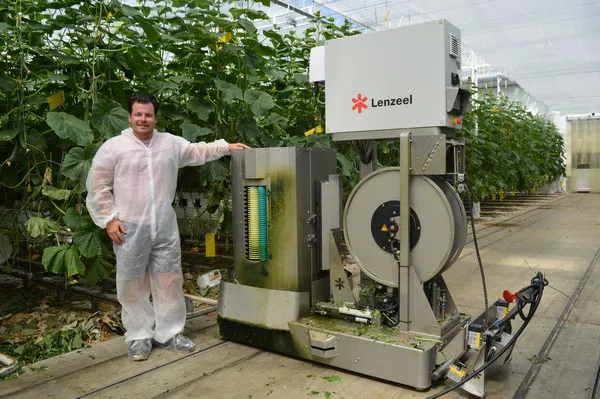
Stijn next to the Diplo robot in the greenhouse at Multigrow Grashoek
Claw
What is immediately noticeable when entering is that there is a robust robot in the cucumber greenhouse. The Diplo leaf-picking robot is powered by a three-phase current. Thanks to its moving platform, the robot can move from one tube rail to another over the center aisle. Using tags next to each row, in which the length of the row and the distance between rows is entered, the robot knows how long the row is and the distance to transverse.
Jan Lenders and Ed Zeelen founded Lenzeel and designed the Diplo leaf picking robot. A special part of the robot is the 'claw' that helps the robot to drive properly over the pipe rail. The claw ensures that the cable remains on one side of the central path and is automatically hooked up to the beginning of the pipe rail by means of a magnetic block. This enables the robot to do its work completely autonomously. Once it has been fixed to the head of the pipe rail, the robot can enter the row. From here, the robot rolls on and the reel on the platform ensures that the cable is unrolled and rolled up.
Lenzeel, headed by Jan Lenders and Ed Zeelen, uses existing technology for the platform, but it has devised its own technology to ensure that the robot can drive over the tubular rail properly. For the layman, this technique can best be described as a magnetic block with a claw, which is attached to the head of the pipe rail when it is driven into the pipe rail. The robot then rolls on, and a reel on the platform ensures that the plug is unrolled and rolled up.
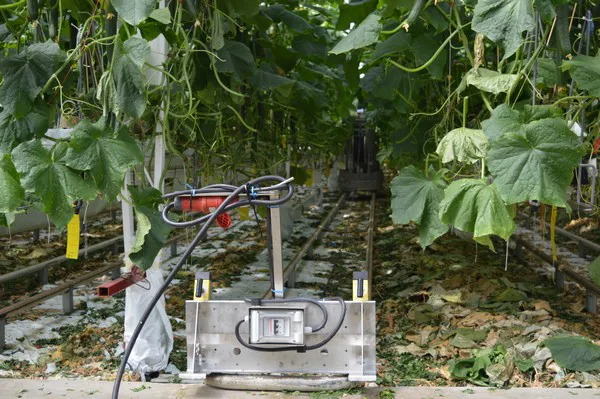
The 'claw'
Hoover or lawnmower?
Once at the end of the row, the robot turns around. Or rather, it is the picking unit, which looks like a horticultural hoover, that is turning round. Stijn understands the comparison with a hoover. "It makes noise because it sucks and blows. There's no need to be alarmed by that. The Diplo handles the plants very subtly."
Not much later, we see it with our own eyes. Suction ensures that the plant leaves pass between two rotating rollers and are then chopped. Afterwards, the blower, driven by a large fan, ensures that the leaves come out again via a snail shell construction.
Watch another video here, in which the robot picks the leaves
The Diplo robot also looks a bit like a lawnmower. This comparison does not bother Stijn either. "You don't cut grass with scissors on a large scale. Partly on the advice of growers, we have chosen to work with this system instead of a robotic arm with scissors when picking leaves."
Last year, a prototype of the robot could already be seen on this channel. The robot then drove through the greenhouse of a grower in North Limburg. At that time not yet fully automatic. "Compared to last year, we use a different platform for driving. The technology we use for leaf picking has not really changed. What is different from last year is that we have now put thousands of hours of Diplo into operation at several growers, with great success. The fact that growers know how to find me immediately if there is a problem shows me that they really need the robot."
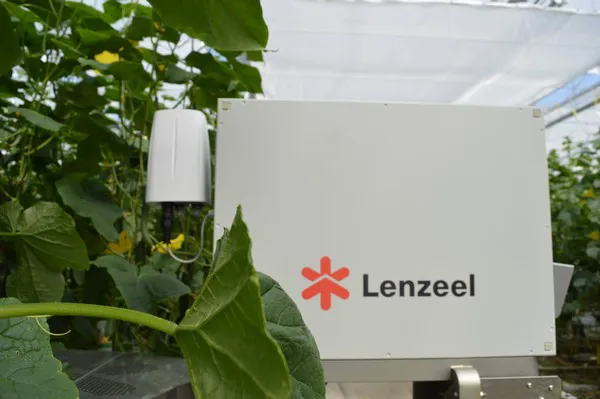
In case of failure, the grower receives a signal thanks to the integration of a SIM card
Labor-saving
Cucumber growers Dion and Thom van Mullekom confirm this when we meet them both separately in the company canteen. Dion: "People often do not like picking leaves, but it is an important task. We can now let the robot do a significant part of the work and thus reduce the labor peak.
Stijn's experience is that the robot picks away at least eighty percent of the leaves, equal to a labor-saving of fifty percent. However, he hears from growers in practice that the percentage of labor savings is often even higher. In the greenhouse in Grashoek, the robot takes about ten minutes to complete one 130-meter path. The robot stops for a moment only if there is a harvest to be done. "We do not have to worry about recharging times because we work without batteries. This would also make the robot much heavier. That would put extra strain on the pipe rails."
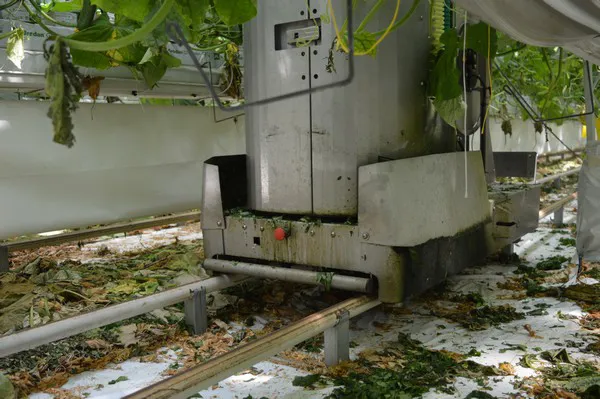
Working autonomously
At Multigrow Grashoek, they work with one Diplo robot on 5.7 hectares and with a planting distance of 3.16 plants per meter in spring and 2.38 plants per meter in summer. "We try to achieve almost six hectares here with one robot instead of five," says Thom. The capacity of one robot is around five hectares. Stijn indicates that growers from Grashoek maximize this by using the robot in a smart way. "They have really made the robot part of the cultivation process," says Thom. "With a larger planting distance, the robot can drive faster," indicates Tom. Smiling: "We were soon making more hours than Lenzeel had calculated."
Not all growers who are now working with the robot can let the robot drive fully automatically. Stijn knows of one grower who has appointed an operator to continuously control two robots. "This grower does not have an optimally laid-out pipe rail at the moment and has opted for this solution. He can now do his leaf picking with far fewer people. The grower is going to have the tubular rails adjusted. "That will make things easier for the robot, which means that this grower will also be able to let the robot work completely autonomously next year."
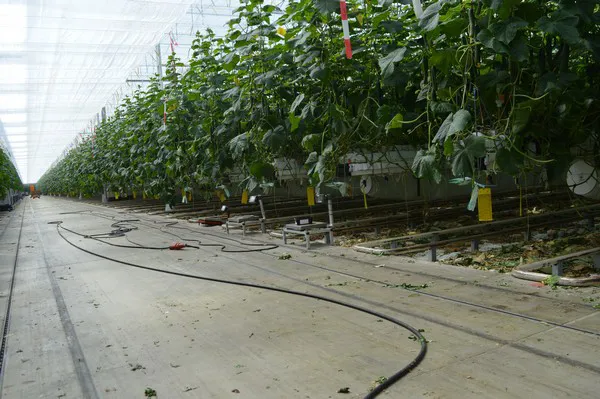
The robot is plugged in
Integrating into the greenhouse
"They say that you have to become one with the machine. That is precisely what the grower has to do", Stijn continues. "That means that they have to integrate the robot as well as possible into their crop, into their greenhouse." As an example, he gives the 'neat hanging away' of the plants. "If you do that and keep the rows tight by making good use of hooks and clips, the robot picks the leaves better." Re-picking by humans will still be necessary. "Growers do that for the plants at the head of the rows and for the bulk. The robot does not pluck the stems and only removes the leaf disc.
At Multigrow Grashoek, they are therefore still curious about the picking performance when it becomes more humid in the greenhouse in the autumn, and there is less irradiation. Thom: "Then you can get moister leaves, and that makes picking more difficult for the robot. Sometimes you see that the leaf is sucked into the robot but is not entirely grated." Erwinia, a bacterium that can cause the plant to rot, sometimes plays a role in cucumber cultivation. This is also occasionally an issue at Multigrow Grashoek. Dion: "So far, this year has not been too bad." The stems with wounds left by the robot can be a risk, the growers know.
As far as the fungus is concerned, Stijn indicates that the test phase and other growers' experiences have already shown that Erwinia does not pose a greater risk after picking with the robot compared to picking by hand. "Picking by hand also leaves wounds."
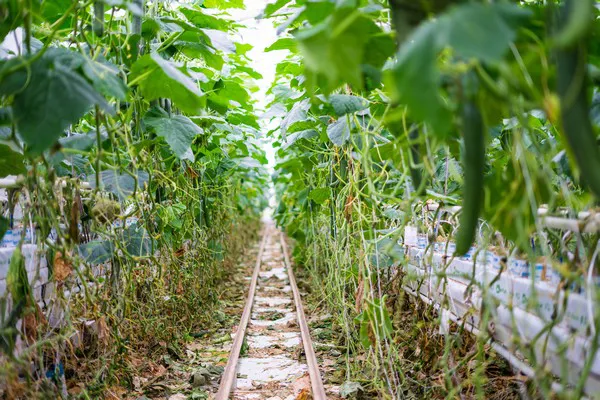
A plucked row
"No vision is an advantage"
In the context of integration of 'making it easier for the robot in the greenhouse,' Multigrow Grashoek's investment in air treatment by means of the well-known trunks helps. "Better air movement is the result," says Thom. "Moreover, good leaf picking ensures that the crop remains open. That, in turn, prevents problems such as Erwinia." All growers working with the Diplo leaf-picking robot want to use the robot as much and as long as possible. Thom saw from colleagues that the gutter height, among other things, makes a difference. "For growers with gutters on the ground, the robot can start picking faster because the leaves start lower. We were a bit later."
When choosing to work with the Diplo robot, there was another consideration in addition to the above benefits for the cucumber growers. "The robot is very solid, like the other robots that Jan Lenders worked on. We also have a packing robot in the shed and a robot for unfolding crates. The leaf-picking robot is 'stupid,' by which I mean that it has no vision technology. We think that is an advantage." Not that the growers are not already looking further. They would like to add a UV application now, for instance, to combat mildew. At the moment, UV is only used to disinfect the leaf-picking robot itself.
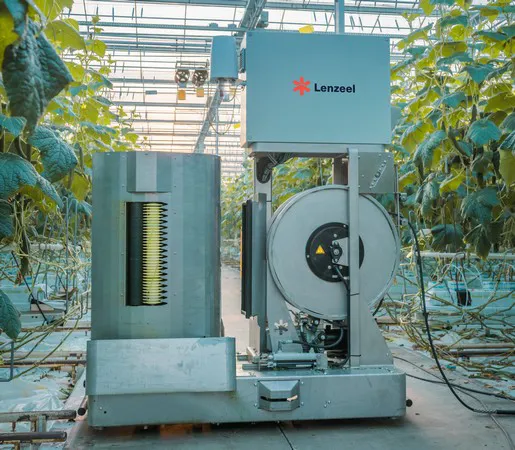
Business case
Lenzeel is producing a new series of robots for the coming year. Growers who are interested can contact Stijn including to calculate the business case. "The average grower goes around the greenhouse to pick leaves between one and a half to two times a week. Just calculate what the labor savings will be if the robot makes a significant contribution to that."
With financing options, which Stijn is happy to explain, Lenzeel tries to help growers to make the investment. Meanwhile, there is already international interest. "This autumn, there will be people coming over from Canada again." "The same ones again?" asks Thom. "No, new ones," Stijn indicates. "We are very satisfied with how things are going already," and so are growers Thom and Dion. Thom also sees opportunities for other growers. "The cultivation schedules shift nowadays, which means that the work peaks are larger. That offers opportunities for the robot." Stijn nods in agreement. "It is not our intention to stop at this leaf-picking robot. We definitely have ambitions to go further."
For more information:
Stijn Linders 
Lenzeel BV
Groesweg 30
5993 NN Maasbree
[email protected]
www.lenzeel.com
